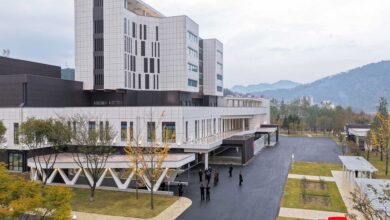On May 24, 2008 Kim Jong Il visited the Ryonghung Temple halfway up Mt Paegun, whose name was derived from the white clouds shrouding the high mountain.
He said to a monk at the temple, “I have come all the way here as I have heard that the relics at the Ryonghung Temple have been preserved in their original state.”
Then he went on to say: The temple is a cultural property that showcases our ancestors’ excellent architecture and superb artistic talent. It was not damaged during the Fatherland Liberation War, probably because the enemy did not bombard this area to protect a host of his remnants and spies who were in hiding around here. Kim Tok Gun, the prototype of the hero of the feature film The Unforgettable Man, fought in this mountainous area.
Looking round the temple, the General showed particular concern for the antiques and praised them for their authenticity–the verse couplets engraved on the four pillars of the Taeung Hall, the image of Buddha made of wood and painted in living colours, the genuine sculptures of mythical animals in the shape of monkeys and pictures hanging on the walls, the painted brackets of the lower walls, the plate of the Taeung Hall, the large wooden vessel for rice cake and bath tub made of willow, etc.
The monk was happy to see the General’s broad smile and began to explain the writing inscribed in small letters on the “plate bearing the records of the reconstructed incense-burning hall of the Songbul Temple in Mt Paegun in Hamhung.”
Once upon a time the Taeung Hall had been burned down for unknown reason. A squire sent a 13-year-old carpenter to reconstruct the hall. The reconstruction work was done in 49 days. The monks, including their head, did not want to pay the boy. They drove the boy away and decided to put the finishing touches to the building by themselves. However, it was not so easy as they presumed, and they re-invited the boy and apologized for their behaviour.
The carpenter worked hard to complete the building but he did not wedge one of the four pillars that supported the ceiling. Consequently, the ceiling remains tilting slightly.
Kim Jong Il listened in silence to the monk’s explanation.
The monk, pointing to the sculpture of a crab on the back wall of the Unha Pavilion that stood on the opposite side of the Taeung Hall, said, “Such a sculpture cannot be found elsewhere. If a stone is fastened on the back of a crab, the creature will naturally hold it up to the death. In my opinion it was believed that the crab sculpture would support the Unha Pavilion for ever.”
Nodding in agreement the General said: In ascertaining antiques, people tend to conjecture about them. When a historical site or relic is unearthed, data concerning it are not readily available and contemporary people cannot be found. So conjecture is a preferred way of interpreting it. But we should believe in the legends that have been transmitted historically.
Surveying the Taeung Hall again, he asked on which side the building reconstructed by the young carpenter tilted.
The monk was surprised because he presumed that Kim Jong Il was not listening carefully when he was explaining the above plate.
“On the back side, sir. Over there,” he replied.
The General moved towards where he was pointing. He studied the pillar, which was said to have been set up by the carpenter.
He said to the officials:
“Historical relics are precious cultural assets of the country. So it is important to keep them in a good state of maintenance and conduct effective education by means of them as they are permeated with the resourcefulness and talent of our people. We should work efficiently to properly sustain the features of the nation’s excellent cultural heritage, so as to implant greater pride and dignity of the Korean nation in our people.”
After touring the Ryonghung Temple, he got into the car and left for the newly-built Paegunsan Pleasure Ground.
Passing through the pine and pine-nut trees standing upright in the area of the scenic spot, he said that the tall, upright trees presented a scene of extraordinary beauty.
When he arrived at a pavilion in a dense forest, a senior official of the county Party committee explained that it doubled as a dance hall.
Kim Jong Il told the woman official that the pavilion was excellent, praising that it blended well with the landscape although the topographical conditions were not favourable.
Then he saw a TV in it and said smilingly that the power line had reached the spot.
Though everything was in short supply, the county had ensured that the power line be laid as far as the pavilion 16km away from the township, so that the holidaymakers could enjoy themselves in the scenic spot.
The General asked the official if there was a TV at the Ryonghung Temple.
She said apologetically that the temple was not supplied with electricity and she would soon ensure that the monk could watch TV, at least by installing a battery.
Saying that he would send Arirang TV, the General stressed:
“You should ensure that the monk at the Ryonghung Temple can watch TV. Then he will be a man who supports socialism, not the one who dilutes it.”

